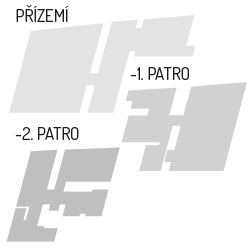Stefan Häfner, Ota Prouza, Marcel Schmitz Crossroads
Museum Montanelli
20. November 2015 - 28. February 2016
curators Ivana Brádková, Terezie Zemánková, Dadja Altenburg-Kohl
„Crossroads“, a new joint project by ABCD and the Museum Montanelli presents works by three contemporary international art brut artists who share a common theme: the city as a place for life. With his three-dimensional residential modules and their elaborate interior furnishings, German artist Stefan Häfner creates his own vision of the “city of the future.” Belgium’s Marcel Schmitz produces drawings, paintings, and graphic works through which he explores the anonymous city as a monotonous planned structure composed of various layers of two-dimensional planes. On pieces of paper pasted together into strips several meters long, the recently discovered Czech artist Ota Prouza draws endless tangles of roads, highway interchanges, railroads and tracks surrounded by skyscrapers seen from a bird’s-eye perspective. All three “mental urbanists” present their vision of an absolutely depopulated or dehumanized future in which there is no more place for man because the buildings, roads, and rails have taken on a life of their own. It is as if the city has metamorphosed into a sprawling organism that has consumed human society, which by its own hypertrophy has forfeited its right to exist. The city’s windows are transformed into thousands of mosaic-like insect eyes, the roads are like arteries whose intersections resemble bodily organs, trucks and trains take on anthropomorphic features. They are “different cities” – though born of human design, they no longer need mankind for their existence. They throb with their own pulse, they feed themselves and live their own lives. We encounter them on “The Day After,” immediately following a catastrophe that has passed without notice.
What news of the world do these artists offer us? Does our civilization stand at a crossroads? Are these cities of the future, whose silence is almost agonizing, a physical embodiment of post-apocalyptic megalopolises in which time and motion has stopped – mere lights flickering within the infinite space of the universe? Or do they perhaps offer hope, are they a refuge, a hive in which mankind may survive in anonymous harmony?
Doc. IVANA BRÁDKOVÁ, vice chairwoman ABCD. Graduated from the Theatre Faculty of the Academy of Performing Arts, Department of Stage Design. She collaborates with numerous professional theatres and the public-service Czech Television. She created about 400 mainly costume stage designs for theatre, TV and film. She received the degree Associate Professor (doc.) in 2005.
TEREZIE ZEMÁNKOVÁ, Ph.D., chairwoman ABCD. Graduated from the Philosophical Faculty of the Charles University in Prague, field Theory of Culture, and also studied at the Paris Sorbonna. Her dissertation focused on the subject of Art Brut in the perspective of Cultural Studies. She is active as independent cultural journalist and publicist and exhibition curator.
Prof. MUDr. DADJA ALTENBURG-KOHL, physician, philanthropist. Founder of the Museum Montanelli in Prague. Advisor to the Europäisches Kulturforum in Berlin. Mrs. Altenburg-Kohl has curated dozens of exhibits at home and abroad, where she has presented Czech art at leading cultural institutions for more than 20 years. She is also an art collector and the curator and director of the Museum Montanelli.







